
The Shiromani Gurdwara Parbandhak Committee is an organization in India responsible for the management of Gurdwaras, Sikh places of worship in states of Punjab and Himachal Pradesh and the union territory of Chandigarh. SGPC also administers Darbar Sahib in Amritsar.
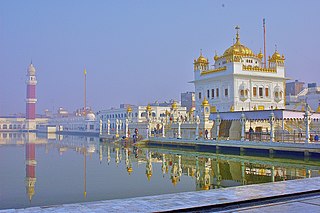
Tarn Taran Sahib is a city in the Majha region of the state of Punjab, in northern India. It is the district headquarters and hosts the municipal council of Tarn Taran district. Gurdwara Sri Tarn Taran Sahib, a prominent Sikh shrine is located in the central part of the city.
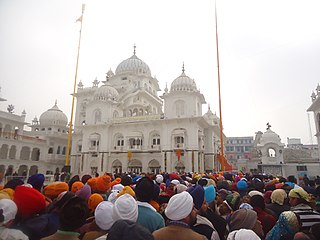
Takht Sri Patna Sahib also known as Takhat Sri Harimandir Ji, Patna Sahib, is one of the five takhts of the Sikhs, located in Patna, Bihar, India.

Sobha Singh was an artist from Punjab, India.
Ravidassia or the Ravidas Panth is a religion based on the teachings of Guru Ravidas. It was considered a sect within Sikhism until 2009. The Sikh gurus and the Guru Granth Sahib are considered reverential, but not central figures in the religion.
Balachaur is a town in Balachaur Tehsil in the Shaheed Bhagat Singh Nagar District of Punjab, India.
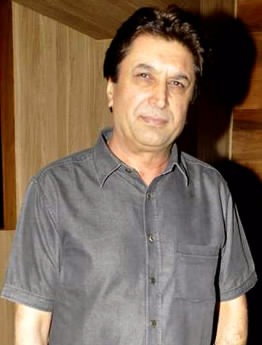
Mangal Singh Dhillon was an Indian actor, writer, director and film producer. He was born in Wander Jatana near Kotkapura in Faridkot district, Punjab.

Giani Gurdit Singh was born in Mithewal village in the state of Punjab, India. He was considered one of the greatest contemporary writers in Punjabi, and his book Mera Pind is regarded as a classic. It is now in its 14th edition and has been in print continuously since 1961. He was also a pioneering journalist, the Owner-Editor of Parkash 1947–1978. He was also the editor of Singh Sabha Patrika, a monthly magazine of Sikh history and divinity. Giani Gurdit Singh graduated as "Giani" from Punjab University, Lahore in 1945, and he specialised in literature, divinity, history and folklore. He was a member of the Punjab Legislative Council from 1956 to 1962. He contributed to the debates at that time and in the creation of Punjabi University, Patiala and the recognition of Takht Sri Damdama Sahib, Talwandi Sabo, as the 5th Takht of the Sikhs. He was General Secretary of the Singh Sabha Shatabadi Committee, Amritsar, renamed Kendriya Sri Guru Singh Sabha. As the editor of the magazine Singh Sabha Patrika, he focused on issues of importance to the Sikhs. He also established two Guru Granth Vidya Kendras, one in Chandigarh and another in Mehrauli, Delhi.

Mohinder Singh Randhawa or M. S. Randhawa was an Indian historian, civil servant, botanist, and author. He played major roles in the establishment of agricultural research in India, the Green Revolution in India, resettling Punjabis uprooted by Partition as the Director-General of Rehabilitation, establishing the city of Chandigarh and documenting the arts of Punjab, the history of agriculture in India. A biographer, Gulzar Singh Sandhu, gave him the sobriquet Punjab da Chhewan Dariya, the sixth river of Punjab.

Harjinder Singh Dilgeer He is the only author who has written Complete History of the Sikhs and has translated Guru Granth Sahib in English and has published NEW MAHAN KOSH Encyclopedia of Sikh literature, Punjab & Sikh History {3 of the 4 volumes of the NEW Mahan Kosh have been published in March 2021. He has written in detail about the concept and the history of Akal Takht Sahib, Sikh culture, Shiromani Akali Dal, history of Anandpur Sahib, and Kiratpur Sahib, Dictionary of Sikh Philosophy etc. The Sikh Reference Book is his magnum opus. 'The Sikh Reference Book' is an encyclopedia consisting of more than 2400 biographies, complete chronology of Sikh history, 400 concepts of Sikh philosophy as well more than 800 Sikh shrines. He has produced a Sikh Encyclopedia CD-ROM. His latest books are Encyclopedia of Jalandhar (English), Banda Singh Bahadur, Sikh Twareekh in five volumes, Sikh History in ten volumes ; and English translations of Nitnaym and Sukhmani Sahib.. His latest work is the English translation of Guru Granth Sahib, in seven volumes and a Sikh encyclopedia named Nawah Mahan Kosh consisting of four volumes.

Dalip Kaur Tiwana was one of the foremost novelists and short-story writers of contemporary Punjabi literature. She won awards, both regional and national, and was a widely translated author. She retired as Professor of Punjabi, and Dean, from Punjabi University, Patiala. She is widely credited as a tour-de-force in the creation of the contemporary literature in the Punjabi language.

The Panjab Digital Library is a voluntary organization digitizing and preserving the cultural heritage of Panjab since 2003. With over 65 million digitized pages, it is the biggest resource of digital material on Panjab. There are many historically significant documents stored and made available online. Its scope covers Sikh and Punjabi culture. The library funded by The Nanakshahi Trust was launched online in August 2009. Its base office is located at Chandigarh, India.
Nanak Naam Jahaz Hai is a 1969 National Award winning Punjabi film directed by Ram Maheshwary, starring Prithviraj Kapoor, I. S. Johar, Nishi, Veena and Vimi. The film is based on a true incident which took place at Golden Temple, Amritsar. The film was awarded the 1970 National Film Award for Best Feature Film in Punjabi, and National Film Award for Best Music Direction,
Nagrota Surian is a town in Nagrota Surian Mandal, Kangra District, in the Indian state of Himachal Pradesh. Nagrota Surian is 45.2 km from the district headquarters Dharamshala. It is about 260 km from the state capital Shimla. Block Head office is also available in Nagrota surian.

Dr. Balbir Singh Sahitya Kendra is a memorial, library and art gallery in the name of Sikh scholar Dr Balbir Singh, which is the nucleus of advanced study for research in comparative religion, philosophy & culture. It is now a department of Punjabi University Patiala and located at 20, Pritam road, Dehradun. The place was earlier residence of a Sikh scholar Balbir Singh (scholar). It has facilities for visiting scholars & university researchers to carry out research on comparative religion, Sikh studies and history & culture of Punjab.

Gurpreet Singh is a modern Indian painter of local acclaim, he also has a hand in photography. He had received few awards and held painting exhibitions in Punjab.
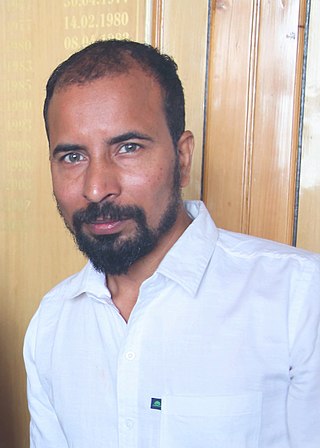
Gurpreet Singh Dhuri is an Indian sculptor, hailing from the Ghanaur Khurd Dhuri area of Punjab. Gurpreet Dhuri is known for his clay modeling and portraiture in medium of sculpture. Gurpreet Singh Dhuri loves to be called Gurpreet Dhuri and alumni of Government College of Arts, Chandigarh. His upbringing in a working-class family has taught him to be tough and work passionately to rise. But unlike many who shared similar socio economic background, he has not given up to destiny. He is a contemporary sculptor and prost artist who has worked in Punjab, Chandigarh, Delhi and Mumbai. Completed his Graduation and masters of Fine art BFA and MFA from Government College of Arts Chandigarh. He has worked as artist at dirty Hands studio for a period of five years where he was trained in pros. He is founder member of Studio hash, Delhi among other fellow artist Rake Kumar, Harpree Singh, Akash’s Gauir. Recently they have done a full figure Sili Sculpture of Shri Nek Chand maker of Rock Garden of Chandigarh.
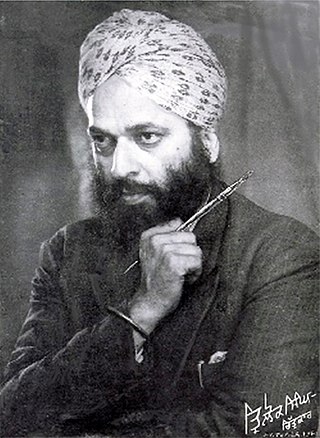
Trilok Singh Chitarkar (1914-1990) was a versatile Indian painter. He has unique style of presenting himself through variety of themes - Sikh religion, history, culture, folk lore, love legends, portraits, social evils, nature, illustration of Gurbani, Shabads, visuals in Punjabi Encyclopedia and books. He was well versed with deep knowledge of Gurbani, history and religion. He knew many languages i.e. Gurmukhi, Punjabi, Hindi, English, Urdu, Persian, Assamese and Bengali. He translated articles from Bengali to Punjabi and published these in the book titled Bangla De Daab in 1974. The Artist was honoured in 1973 by the Chief Minister, Punjab,India Giani Zail Singh at a state level function organised at his residence, Chitralok, Patiala. Language department, Punjab published a book in Punjabi-Chitralok's Contribution to Art and released on the 70th birthday of the artist, 10 December 1984 at a special function organised in Central Library at Patiala for his contribution to Art.
He is the first Punjabi Artist on whose works Ph.D. degree Art of Trilok Singh was awarded by Punjabi University, Patiala. A Gold medal has been established in the name of the artist and it is awarded to the topper of M.A. Fine Arts. He was appointed as a State Artist in erstwhile PEPSU state of Punjab in 1948 and later worked as Artist in Department of Languages, Punjab. He lived and worked all over India and spent last years of his life in Patiala town in Punjab state in India.














